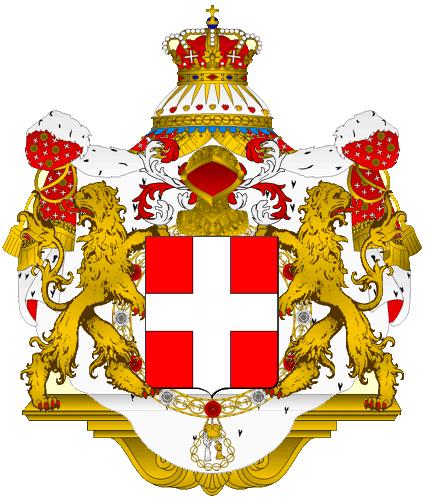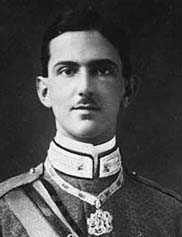Umberto II King of Italy 1699
- Born: 15 Sep 1904, Racconigi, Italy 1699
- Marriage (1): Marie José Princess of Belgium on 8 Jan 1930 in Rome, Lazio, Italy 1699
- Died: 18 Mar 1983, Geneva, Genève, Switzerland at age 78 1699
- Buried: Abbaye de Hautecombe (Savoie, Champagne-Ardenne, France)
 Another name for Umberto was Umberto Nicola Tomasso Giovanni Maria.1708 Another name for Umberto was Umberto Nicola Tomasso Giovanni Maria.1708

 General Notes: General Notes:
Umberto II, occasionally anglicized as Humbert II, (September 15, 1904 - March 18, 1983), the last King of Italy, nicknamed the King of May (Italian: Re di Maggio), was born the Prince of Piedmont. He served as the last King of Italy for slightly over a month, from May 9, 1946 to June 12, 1946.
Prince of Piedmont
The Prince of Piedmont was educated to a military career and in time became the commander in chief of the Northern Armies, and then of the Southern ones. However his role was merely formal, the concrete command belonging to Mussolini. By mutual agreement Umberto and Mussolini always kept at distance. It has been conjectured that Mussolini had collected a secret dossier on Umberto, but this folder (which is said to have been found after the dictator was shot), was never seen.
Following the Savoyards' tradition ("Only one Savoy reigns at a time"), he kept apart from active politics until he was finally named the Lieutenant. Only in one case, while he was in Germany for a royal wedding, did he make an exception, when he autonomously arranged to meet Hitler (it is likely that he himself proposed the meeting). This action was not considered proper, given the international situation, and Umberto was later even more severely banned from political events.
In 1943, the Crown Princess Maria José, the daughter of King Albert I of Belgium, was involved in vain attempts to arrange a separate peace treaty between Italy and the United States, and her interlocutor from the Vatican was Monsignor Giovanni Battista Montini, a senior diplomat who later became Pope Paul VI. Her attempts were not sponsored by the king and Umberto was not (directly, at least) involved in them. After her failure (she never met the American agents), she was sent with her children to Sarre, in Aosta Valley, and isolated from the political life of the Royal House.
Following the overthrow of Benito Mussolini in 1943, King Victor Emmanuel handed over his constitutional functions to Umberto, who was made Lieutenant General of the Realm, and left Italy for Egypt.
King of Italy
Umberto earned for himself widespread praise for his role in the following three years. Some believe that had Victor Emmanuel III handed over the throne in 1943, the monarchy would have won the 1946 referendum on its survival. Victor Emmanuel's failure proved to be one of his many major misjudgments.
A part of the Italian monarchists expressed doubts about the correctness of the referendum, claiming that millions of voters, many of them pro-monarchist, were unable to vote because they had not yet been able to return to their own local areas to register. Nor had the issue of Italy's borders, and so the voting rights of those in disputed areas, been satisfactorily clarified. Other allegations too have been made about voter manipulation, while even the issue of how to interpret the votes became controversial, as it appeared that not just a majority of those validly voting but of those votes cast (including spoiled votes), was needed to reach an outcome in the event the monarchy lost by a tight margin. The referendum however has always been considered fair, with the exception of the mentioned monarchist minority.
Umberto had by the time of the referendum become king, Victor Emmanuel having reluctantly and belatedly abdicated a few weeks before. Umberto served as king for 33 days. The monarchy formally ended on June 12, 1946 and Umberto became a king in exile, leaving Italy forever. Prime Minister Alcide De Gasperi assumed office as Italy's interim Head of State.
In Exile
Umberto and Maria José separated in exile; it was indeed an arranged marriage, following a long tradition of royal families, even if some observers alleged that she was really fascinated by her husband, an elegant tombeur de femmes. However, Humbert's sexual interests lay elsewhere. He was a playboy of 'peculiar tastes' (in the words of one royal website) or had an 'inability to distinguish between the sexes' (as another royal biographer put it - a reference to the former king's rumored bisexuality). This knowledge was used by foreign governments hostile to the Savoyard monarchy's survival to ensure the Vatican's opposition to the monarchical cause in the 1946 referendum. Pope Pius XII atoned for this 'failure' by refusing to meet the elected presidents of Italy during his lifetime. Pope John XXIII reversed this policy on his election.
King Umberto lived for 35 years in exile, first in Switzerland and later in Portugal, a popular old gentleman, nicknamed 'Europe's grandfather', at many of Europe's royal weddings. While during Umberto's lifetime the 1947 constitution of the Italian Republic barred all male heirs to the defunct Italian throne from setting foot on Italian soil again, female members of the Savoy family were not barred, but out of respect for Umberto and his son, Crown Prince Victor Emmanuel, Maria José and her daughters declined to return to their native land, the exiled queen making her first return to her late husband's kingdom only in the 1980s. When it was revealed that the exiled king was terminally ill, President Sandro Pertini, who as a young republican firebrand had played a leading role on the republican side in campaigning against the monarchy and Umberto, urged the Italian Parliament to amend the constitution to let the King return to die in his homeland. However, before this could happen, Umberto died. The funeral for the last King of Italy was held in Savoy, but no member of the Italian Government attended. Looking back later, former Prime Minister Andreotti believed their absence a mistake and disrespectful to a decent and honourable man, who in different circumstances could have made a fine Italian king. But by the time he inherited the throne, the monarchy, through its association with Mussolini and fascism, had been fatally undermined. The 999-year reign of the Savoyards in various duchies and kingdoms, first in Northern Italy, then over the whole peninsula, had come to an end. 1699
 Birth Notes: Birth Notes:
Chateau de Racconigi

 Life Events: Life Events:

1. Acceded: King of Italy, 9 May 1946-12 Jun 1946. 1699
2. Acceded: Titular King of Italy, 12 Jun 1946-18 Mar 1983. 1699

Umberto married Marie José Princess of Belgium on 8 Jan 1930 in Rome, Lazio, Italy.1699 (Marie José Princess of Belgium was born on 4 Aug 1906 in Ostende, West-Vlaanderen, Belgium,1699 died on 27 Jan 2001 in Switzerland 1699,1708 and was buried on 2 Feb 2001 in Abbaye de Hautecombe (Savoie, Champagne-Ardenne, France) 1708.)
|



 Another name for Umberto was Umberto Nicola Tomasso Giovanni Maria.
Another name for Umberto was Umberto Nicola Tomasso Giovanni Maria.